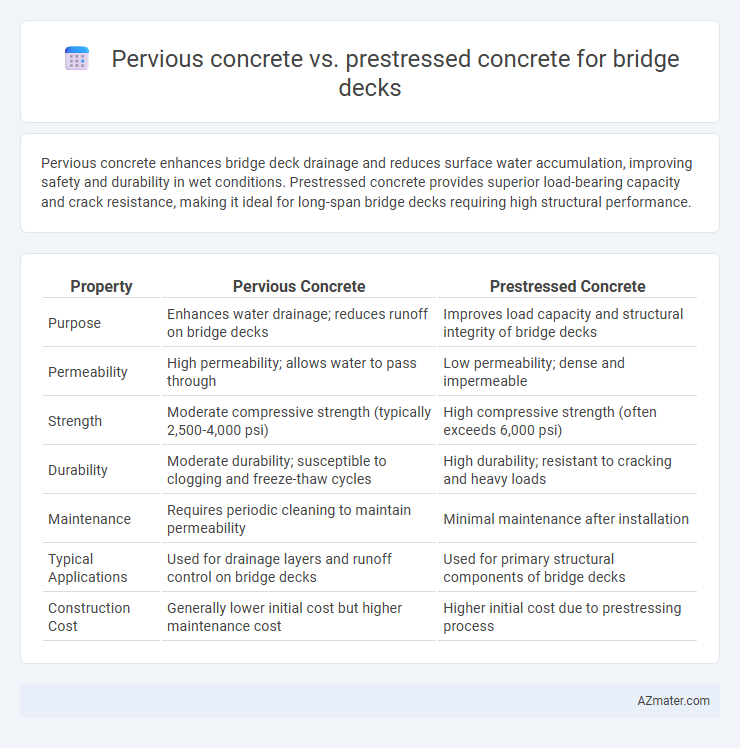Pervious concrete enhances bridge deck drainage and reduces surface water accumulation, improving safety and durability in wet conditions. Prestressed concrete provides superior load-bearing capacity and crack resistance, making it ideal for long-span bridge decks requiring high structural performance.
Table of Comparison
| Property | Pervious Concrete | Prestressed Concrete |
|---|---|---|
| Purpose | Enhances water drainage; reduces runoff on bridge decks | Improves load capacity and structural integrity of bridge decks |
| Permeability | High permeability; allows water to pass through | Low permeability; dense and impermeable |
| Strength | Moderate compressive strength (typically 2,500-4,000 psi) | High compressive strength (often exceeds 6,000 psi) |
| Durability | Moderate durability; susceptible to clogging and freeze-thaw cycles | High durability; resistant to cracking and heavy loads |
| Maintenance | Requires periodic cleaning to maintain permeability | Minimal maintenance after installation |
| Typical Applications | Used for drainage layers and runoff control on bridge decks | Used for primary structural components of bridge decks |
| Construction Cost | Generally lower initial cost but higher maintenance cost | Higher initial cost due to prestressing process |
Introduction: Pervious Concrete vs Prestressed Concrete
Pervious concrete for bridge decks offers enhanced stormwater management by allowing water infiltration, reducing runoff and improving durability in wet environments. Prestressed concrete provides superior strength and load-bearing capacity by pre-tensioning steel reinforcement, making it ideal for long-span bridge decks with heavy traffic. Selecting between these materials depends on specific project requirements such as environmental conditions, structural demands, and maintenance considerations.
Material Composition and Properties
Pervious concrete for bridge decks typically consists of a mixture of coarse aggregates, cement, and minimal sand to create a porous structure that enhances water drainage and reduces hydroplaning risks. Prestressed concrete incorporates high-strength steel tendons tensioned before loading, significantly increasing tensile strength and allowing longer spans with reduced cross-sectional thickness. While pervious concrete emphasizes permeability and environmental benefits, prestressed concrete prioritizes mechanical strength and durability for heavy load bearing and structural integrity.
Structural Performance and Load Capacity
Pervious concrete offers enhanced drainage and reduced hydrostatic pressure, making it suitable for bridge decks in wet environments but generally exhibits lower compressive strength and load-bearing capacity compared to prestressed concrete. Prestressed concrete significantly improves structural performance by introducing precompression, allowing the bridge deck to handle higher tensile stresses and greater load capacities, which is crucial for long-span and heavily trafficked bridges. The choice between pervious and prestressed concrete depends on balancing permeability and durability needs against structural demands and load requirements.
Durability and Longevity
Pervious concrete offers superior drainage capabilities that reduce water retention and minimize freeze-thaw damage, enhancing the durability of bridge decks in wet climates. Prestressed concrete provides high tensile strength and crack resistance, significantly increasing the longevity of bridge structures under heavy traffic loads. Combining the permeability benefits of pervious concrete with the structural advantages of prestressed concrete can optimize durability and lifespan for modern bridge decks.
Water Drainage and Permeability
Pervious concrete bridge decks offer superior water drainage and permeability compared to prestressed concrete, allowing water to pass through the surface quickly and reducing hydrostatic pressure and the risk of surface water accumulation. This enhanced permeability helps mitigate the potential for freeze-thaw damage and improves safety by minimizing water ponding on the deck, whereas prestressed concrete typically relies on surface drainage systems. The open-graded structure of pervious concrete facilitates rapid infiltration, making it an ideal choice for areas with high rainfall or where effective stormwater management is critical.
Construction Techniques and Installation
Pervious concrete for bridge decks uses specialized mixing and placing methods to ensure proper porosity, requiring careful curing to maintain permeability and structural integrity. Prestressed concrete involves tensioning steel tendons before or after casting, requiring precise tensioning equipment and formwork to control stress distribution and minimize cracking. Installation of pervious concrete demands careful handling to prevent clogging, while prestressed concrete decks often require heavy lifting equipment for placement and careful alignment to support designed load transfer.
Maintenance Requirements
Pervious concrete bridge decks require frequent inspection and cleaning to prevent clogging and ensure proper drainage, which is critical for maintaining permeability and preventing water accumulation. Prestressed concrete decks typically exhibit lower maintenance needs due to their high durability and resistance to cracking under load, reducing the frequency of repairs and surface treatments. Choosing prestressed concrete can lead to longer service intervals, while pervious concrete demands more intensive upkeep to preserve structural integrity and performance.
Environmental Impact and Sustainability
Pervious concrete significantly enhances environmental sustainability by facilitating natural stormwater management through its high permeability, reducing runoff and promoting groundwater recharge. Prestressed concrete offers increased durability and reduced material usage due to its high strength, leading to longer service life and minimized maintenance demands, which contributes to lower environmental footprints over time. Selecting between pervious and prestressed concrete for bridge decks depends on balancing immediate ecological benefits with long-term structural efficiency and lifecycle environmental impacts.
Cost Comparison and Economic Considerations
Pervious concrete generally incurs lower initial costs for bridge decks due to reduced material usage and simplified drainage systems, while prestressed concrete involves higher upfront expenses related to specialized materials and labor but offers enhanced load-bearing capacity and durability. Over the long term, prestressed concrete presents better economic value through reduced maintenance and extended service life, whereas pervious concrete may require more frequent repairs due to its lower strength and susceptibility to clogging. Cost-benefit analysis should consider lifecycle expenses, site-specific drainage requirements, and structural demands to determine the most economically viable option.
Application Suitability for Bridge Decks
Pervious concrete is ideal for bridge decks requiring enhanced drainage and reduced surface water accumulation, improving safety during wet conditions. Prestressed concrete excels in applications demanding high load-bearing capacity and long-span strength, enabling thinner decks and longer bridge spans. Selecting between the two depends on site-specific factors such as traffic load, climate, and structural requirements for durability and performance.

Infographic: Pervious concrete vs Prestressed concrete for Bridge deck
 azmater.com
azmater.com